Exploring the ends of the earth with great people is one of my passions. For many years I’ve wanted to do a trip to Patagonia in the southern tip of South America. This was the year! Our Patagonia adventure began in a city called Puerto Varas, perched on the shore of beautiful Lake Llanquihue–pronounced “Yankee Way.” Also known as the “City of Roses,” Puerto Varas has the appearance of a quaint German village, a reflection of its colonial past. It felt comfortable, friendly, and somehow familiar.
Most of the people who signed up were past WI travelers, but we did get some new friends in the form of Mark and Karla, newly weds from DC, and Beth who joined us from Madison, WI. Past travelers included Joe, Martha, Patti, Tom, Mary Beth, and long-time friends Nelson and Marilyn. We met our local guide, Claudio, at the airport and immediately felt at ease. Claudio was kind, patient, and an excellent guide and ambassador for Patagonia. Everyone in our group loved him!
Patagonia Lake Country
From our beautiful lake edge accommodations we took a ferry to Chiloe Island and visited colorful markets with unique local foods. Every kiosk had a variation of dried oysters, bundles of kelp, and a myriad of flavorful sauces. Fresh fish, clams and mussels were everywhere. Eventually we found lunch in Castro at a place called Octavio’s. We enjoyed Curanto–an enormous meat lovers bonanza of mussels, smoked pork, sausages, salmon, clams all in a big wooden bowl with great red wine. Welcome to Patagonia!
On the second day we woke up to a dazzling view of the snow covered Osorno volcano, a conical “stratovolcano” towering above the landscape. We hiked a windy, exposed trail on the edge of the volcano that did arouse my fear of heights, though no one else seemed to be bothered by the steep slopes. There is something about getting outside your comfort zone in nature that helps people display care and concern for each other. I’ve witnessed this on hundreds of trips, but it is still great to see. Sharing these experiences brings us all together. After the hike we enjoyed coffee and hot chocolate in a mountainside chalet. We were now a “tribe.”
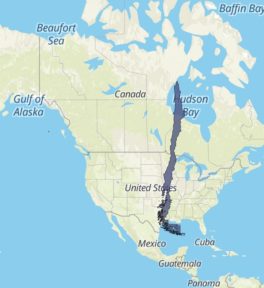
Straits of Magellan
From Puerto Varas, we flew south to Punto Arenas, Claudio’s home town and a beautiful city on the edge of the Strait of Magellan. Claudio took us to a windy overlook and we saw people doing yoga in a beautiful square below. Chile is 2,700 miles long, and it was hard to contemplate that we were near the very southern tip of the New World. We saw a statue of Ferdinand Magellan, and tried to imagine the magnitude of his voyage. Later that afternoon, at Claudio’s suggestion, we took a walking tour of one of the most beautiful and unusual cemeteries I have ever seen. There we saw the tomb of Sara Braun, an interesting business woman and philanthropist. Hers is quite a tale.
This just hints at Chile’s cultural history. There are many descendants of German and eastern European people who came here in the 1800’s, with another big influx after WW II. The mix of Latin, German and Native cultures make this area a fascinating study for its history. Later we drove from Punta Arenas to a huge ranch called “Estancia Fitz Roy” for a delightful morning and afternoon of horseback riding, sheep dipping and shearing, and roasted lamb. In truth, I had thought this part of our trip would be less interesting, but it was so well done that everyone loved it.
Magellanic Penguins
The next day was our big opportunity to go see the Magellanic Penguins on an island in the Strait. We woke up early all excited only to learn that the sea was too rough and our boat had been cancelled. Oh no! That caused us to go into alternative mode. Then, by 10AM we learned the sea had calmed and the penguins were back on. Joy! We walked out a long narrow dock, climbed through a hatch, and set off.
Right off the boat there were penguins and gulls up close. As I love photography, I thought no problem getting some close up mug shots of these birds. After walking this circular path, watching penguins in their burrows, it became clear that the close-up was not a slam-dunk, even with a long lens. After an hour or two, I walked toward the boat a little frustrated over missed photo opportunities. Then, right at the dock, a penguin swam in to shore and proceeded to shimmy and shake and strut about like a little island ambassador. All was forgiven in the missed opportunity department!
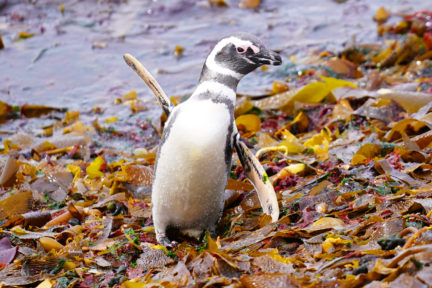
These cute little birds are listed as threatened as their breeding habitat in Argentina is subject to oil spills that kill 20,000+ birds annually. Climate change is also causing a change in fish populations; forcing Magellanic Penguins to swim farther for their food while their mates wait hungrily on land. We, of course, could not tell any of that by watching the several thousand penguins on the island. Such is the state of the wild almost everywhere we go.
Torres Del Paine National Park
After bidding adieu to the penguins we headed to Torres Del Paine National Park, one of the crown jewels of Patagonia. Watching the plains turn to magnificent mountains in the span of a few hours was breathtaking. The golden slanting light of the sun lit up sweeping areas in an extraordinary panorama of light and shadow. Then, our driver whispered, “Puma!” I did not see it, but there was a Puma along the side of the road, looking at us before sliding into the brush. This was Puma country, and there was one hanging around the lodge where we stayed. After a fabulous dinner at the lodge some of our group went out to see the Puma, and they did. Too dark and far away to get any good photos, I was proudly shown blurry shadowy “Puma” blobs the next day by my travel mates.
The next morning we took a spectacular sunny hike right from the hotel across a valley with lakes and mountains. An occasional Gaucho (Chilean cowboy) would ride by on horseback, as we snapped endless photos. Our wonderful guides brought us to a ridge above a lake, facing a stupendous mountain named after a Chilean military man. There, we shared cups of tea and a snack while witnessing an avalanche on the mountainside across the valley. Extraordinary day.
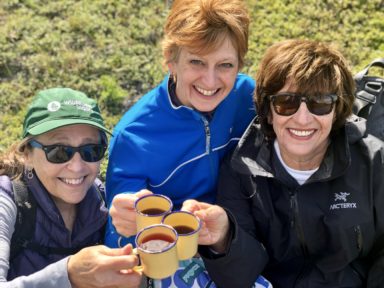
Our hike on day 7 was a transect of a beautiful rise to an aggregate cliff where there is 6,500 year old rock art. We climbed up past guanacos, and saw several skeletal remains of Puma kills. The climb and the view were fantastic. After basking in the scene we had some more tea, then ambled down and across a broad plane filled with tussocks. The back-drop of mountains and guanacos grazing were the perfect images you would imagine of this place. I fell behind the group keeping track of several ambitious photographers, then somehow found myself alone between the main group ahead of me, and the stragglers behind. I came across a sign in the middle of nowhere that said, “Warning. If a Puma approaches you, do not run.” Good advice, as I hate running.
Early the next day we boarded our Mercedes van to head toward Grey Lake, a not very impressive sounding place that turned out to be one of the most beautiful places I have ever visited. Along the way we saw mountain ranges that took our breath away. We arrived to our destination and, after a walk through an interesting forest of twisted trees, emerged out onto a huge alluvial plane of gravel. We hiked over a mile across this gravel, catching glimpses of glaciers and peaks and big blue chunks of ice. At the end of the hike we boarded a double decker boat.
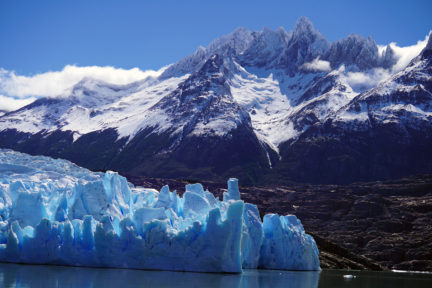
We cruised across Grey Lake, which is more than 1,500 feet deep. Eventually, we caught up to icebergs in the water and saw the leading edge of the misnamed Grey Glacier. I say misnamed because this glacier is a brilliant blue as a result of dense compression of ice. The boat gave us every possible angle to photograph this glacier set in a spectacular bowl of sharp frosted peaks surrounding the lake. Suddenly a pack of sea-kayakers emerged from behind some ice, waving merrily as they paddled past our boat.
Los Cuernos: The Horns of Patagonia
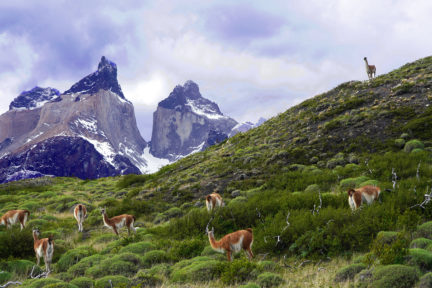
Our last day in Torres Del Paine National Park dawned a little overcast. I thought not so good for our last hike to Los Cuernos, or “the Horns” of Patagonia. This spectacular outcropping of granite peaks is about half-way along the famous “W” Trek Circuit between Los Torres and Paine Grande. After an hour in the van we hiked up a gradual incline to a herd of guanacos. They barely seemed to care that we were right next to them. Standing up on the slope of the hill was a “sentinel” guanaco looking out over the herd to warn of pumas or danger.
The sunlight shifted about, and there were patches of blue sky here and there. After rounding several scenic bends we came to an overlook of the massif rising above a turquoise blue lake. Impressive is an understatement as the unique beauty of this place left everyone in awe. Then, the sun broke through and warmed our group sitting on a green hill. After an hour or so we turned to walk back through an absolutely serene landscape lit by the golden slanting sunlight piercing the clouds.
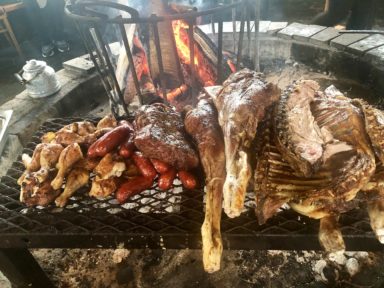
What a way to say good-bye to Patagonia. We returned to our lodge for an incredible feast of lamb, beef, sausages, and yes, vegetarian fare. There were many toasts and everyone was happy. People always ask me what is my favorite trip, and I usually (and truthfully) tell them the one I am currently on. But Patagonia is right up there for spectacular beauty, hospitality, and cultural significance.
Join us!!
Story and photos by Greg Lais


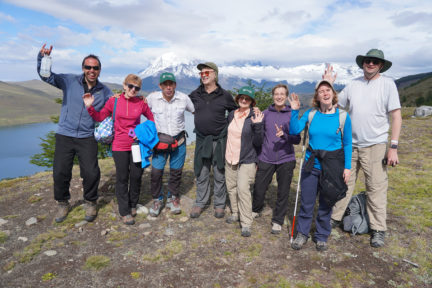
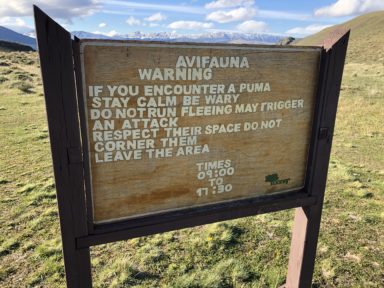
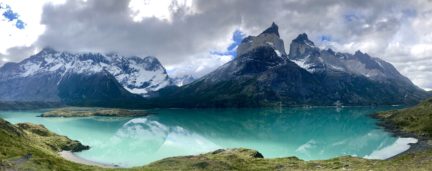
Leave a Reply